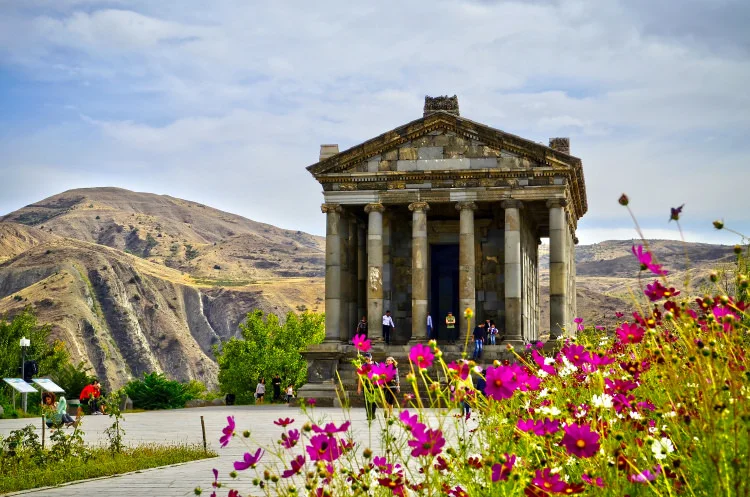Garni Temple: Armenia’s Ancient Wonder
Garni Temple, an awe-inspiring Greco-Roman architectural masterpiece, stands as one of Armenia’s most treasured historical sites. Nestled in the Kotayk Province, approximately 30 kilometers east of Yerevan, this well-preserved pagan temple is a testament to the rich cultural and religious heritage of ancient Armenia. With its stunning location overlooking the Azat River Gorge, Garni Temple remains a fascinating destination for history enthusiasts, travelers, and scholars alike.
Historical Background
The Garni Temple dates back to the 1st century AD and is believed to have been built during the reign of King Tiridates I of the Arsacid dynasty. It is widely accepted that the temple was dedicated to Mihr, the Zoroastrian god of the sun, reflecting the Hellenistic influences that pervaded Armenia during the period. Unlike many other pre-Christian structures that were lost after Armenia adopted Christianity as its state religion in 301 AD, Garni Temple survived, likely due to its use as a summer residence by Armenian royalty.
Architectural Significance
Garni Temple is the only standing Greco-Roman colonnaded structure in Armenia and the former Soviet Union. Its peristyle design, featuring 24 Ionic columns resting on an elevated podium, showcases classical architectural elegance. Built from locally sourced basalt, the temple demonstrates precision in masonry, with intricately carved details that highlight Armenia’s ancient craftsmanship.
The temple’s layout follows a typical Greco-Roman style, with a rectangular cella (inner chamber) and a pronaos (portico) supported by fluted columns. The façade, adorned with detailed friezes and floral motifs, adds to the temple’s grandeur. A monumental staircase leads to the temple’s entrance, emphasizing its imposing presence amidst the surrounding landscape.
Destruction and Restoration
The original Garni Temple was tragically destroyed by an earthquake in 1679. For centuries, its ruins remained scattered until extensive reconstruction efforts took place in the 20th century. Under the direction of Armenian archaeologist Alexander Sahinian, the temple was meticulously restored between 1969 and 1975. This restoration project used original stones and carefully reconstructed missing elements, making Garni one of the best-preserved examples of ancient Armenian architecture.
The Garni Complex
Beyond the temple itself, the Garni historical complex includes several other noteworthy structures:
The Royal Baths: These feature intricate mosaic floors with Greek inscriptions and mythological depictions, revealing the influence of Roman bathing culture in Armenia.
The Fortress Walls: Dating back to the 3rd century BC, these massive stone walls once protected the royal complex from invasions.
The Church of St. Sion: A medieval church constructed in the 7th century, signifying the transition from paganism to Christianity in Armenia.
The Azat River Gorge and the Symphony of Stones: A natural wonder near the temple, where hexagonal basalt columns form a breathtaking rock formation.
Garni Temple in Armenian Culture
Garni Temple remains a symbol of Armenia’s pre-Christian heritage and its deep historical ties to ancient civilizations. Today, the site hosts cultural events, including music festivals, pagan solstice celebrations, and historical reenactments. It continues to be a pilgrimage site for those who admire Armenia’s rich past and enduring legacy.
Visiting Garni Temple
For visitors, Garni Temple offers a unique glimpse into Armenia’s ancient past. The site is open year-round, and guided tours provide valuable insights into its history and significance. The surrounding Garni village offers traditional Armenian hospitality, with opportunities to experience local cuisine and crafts.
Whether one is drawn by history, architecture, or natural beauty, Garni Temple stands as an unparalleled destination, preserving the spirit of Armenia’s ancient world for generations to come.
Join us at TravelSerai to explore the breathtaking Garni Temple with expert guides and seamless travel arrangements. Immerse yourself in history, savor authentic Armenian flavors, and create unforgettable memories on this extraordinary journey!


Comment (0)